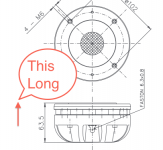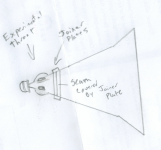Ratio of final horizontal first expansion width to overall horizontal width
Hey Guys.
Does anyone know which expansion rate Danley uses in the Synergy line?
Is it best to keep this ratio between 0.6 and 0.7 or does some of you guys use a different approach to the Synergy design.
One of the reasons for me to be asking this is, that the Synergy horn does not seem to have such step transition between first and second flare.
/Thomas
Hey Guys.
Does anyone know which expansion rate Danley uses in the Synergy line?
Is it best to keep this ratio between 0.6 and 0.7 or does some of you guys use a different approach to the Synergy design.
One of the reasons for me to be asking this is, that the Synergy horn does not seem to have such step transition between first and second flare.
/Thomas
Conical horns do not have a set expansion (flare) rate. The expansion rate (flare) varies along the length of the horn. The rate is fastest (highest frequency) at the throat and progressively gets lower (lowest frequency) near the mouth. More narrow pattern horns ( i.e. 25 X 25 like the SH-25) have slower expansion (flare) rates, while wider pattern horns ( i.e. 90 X 60 like the SH-96) have faster (flare) rates.
You can make the mouth ratio whatever you like. Danley makes a 1:1 horn in the SH-50, SH-60 and SH-25, and a 1:0.67 in the SH-96. SH-69 and SH-64.
http://www.danleysoundlabs.com/danley/wp-content/uploads/2012/01/The-Tapped-Horn.pdf
You can make the mouth ratio whatever you like. Danley makes a 1:1 horn in the SH-50, SH-60 and SH-25, and a 1:0.67 in the SH-96. SH-69 and SH-64.
http://www.danleysoundlabs.com/danley/wp-content/uploads/2012/01/The-Tapped-Horn.pdf
Last edited:
You can make the mouth ratio whatever you like. Danley makes a 1:1 horn in the SH-50, SH-60 and SH-25, and a 1:0.67 in the SH-96. SH-69 and SH-64.
http://www.danleysoundlabs.com/danley/wp-content/uploads/2012/01/The-Tapped-Horn.pdf
Thank you John, you are very helpful - as always!
Good thing you don't charge per advice😉
/Thomas
John, I must appologize for misleading you in regard to my question(s) in #1281.
In reality I only intended to ask about the mouth expansion ratio, but accidently I asked about the expansion (flare) rate!
But as a bonus you covered both rate and ratio
Thanks!
/Thomas
In reality I only intended to ask about the mouth expansion ratio, but accidently I asked about the expansion (flare) rate!
But as a bonus you covered both rate and ratio

Thanks!
/Thomas
Most drivers look like "C" or "D" inside, most modern 1" exit like "D" are around 30mm from diaphragm to phase plug exit.
Art,
What would be an approximated length for a 1.4"? The Faital HF-146 takes a while before they arrive at my doorstep. I'm not sure if it's possible to get the data from directly from Faital along with T/S.
/Thomas
Approximately:Art,
What would be an approximated length for a 1.4"?
Attachments
Approximately:
That's good enough for me

Thanks Art!
/Thomas
..I kinda deserved that one😱
...Stupid Dane..!
My 8" IIRC, and the...
irritated ignitable rectum ****
Please take your foul language elsewhere. This is a serious forum for dedicated audiophiles😀
Guys,
So, I'm fiddling around with different coverage patterns in a 2-way 700-800Hz crossover design.
In relation to the mid tap-in area/quaterwave cancellation notch/halfwave distance to CD acoustic center, I ended up with something like 90x45 degrees. I could also do 80x55 degrees. Should I rather aim at wider and narrower (90x45) than vice versa?
/Thomas
Given the same mouth area, the 80x55 degrees will be constant directivity to a lower frequency than the 90x45.I could also do 80x55 degrees. Should I rather aim at wider and narrower (90x45) than vice versa?
/Thomas
Some folks like the sound of lateral reflections, some (like me) would prefer to eliminate them as much as possible.
If I had room for Synergies in my listening room, I'd make them as narrow as possible while still covering about a 2 meter wide listening area, which for my room would be around 50 degrees.
Of course, the 50 degree horn is almost twice as deep as the 90, which is why I don't have room for them in my listening room...
Given the same mouth area, the 80x55 degrees will be constant directivity to a lower frequency than the 90x45.
Some folks like the sound of lateral reflections, some (like me) would prefer to eliminate them as much as possible.
If I had room for Synergies in my listening room, I'd make them as narrow as possible while still covering about a 2 meter wide listening area, which for my room would be around 50 degrees.
Of course, the 50 degree horn is almost twice as deep as the 90, which is why I don't have room for them in my listening room...
Thank you Art!
Size is not so much an issue. The bigger issue is the tap-in area in relation to the quaterwave cancellation notch and the halfwave distance to the acoustic CD center. I can get away with 75x45 degrees, narrowing in will push the tap-in holes to far down the horn sacrificing the quaterwave criteria.
I'm aiming at ~750Hz crossover which by the quaterwave rule sets the tap-in holes at: 34330/(750*4) = 11.44cm.
Before I have the chance to measure the path length of the Faital HF-146 (which will be another 14 days) it's somewhat difficult to know just how much distance is available from the throat to the tap-in.
/Thomas
The thing you'll notice is this is one of the "rules" that most of the Synergy horns don't follow. You will find that the 1/4WL rule has to be followed due to the cancellation notch, but the cross sectional area that the mids tap into is much smaller than what the Synergy patent states as being ideal. This results in the high end frequency range of the mid being a little on the "hot" side and may make it a little more difficult to get the mid to "turn off" in the high frequencies. To counter this, a larger front chamber can be used on the mid to create more compliance and to help form a more effective acoustical low pass filter. My primary focus when dealing with this is to get the phase correct first, then make adjustments in the mid’s front chamber volume and the crossover to correct the frequency response. I can’t speak for everyone here, but my ears are more sensitivitie to phase abnormalities than frequency abnormalities.
I love this picture of the Danley J4. I just had to post it here. Count them, 64 compression drivers on one horn. Got to love it.


That is just AWESOME.
Question.....I was thinking of testing a closed back midrange on a horn by itself to see what the driver was able to reproduce frequency wise. BUT I wondered is this the best way to test the mid or would a normal straight baffle work also?
I was wanting to test the mids on a simple straight baffle first but with the same type of port that would be on the SH. BUT I thought maybe my measurements would be useless if it was not in a horn.
And does anyone know what 15" drivers are used on the SH96/64?
Question.....I was thinking of testing a closed back midrange on a horn by itself to see what the driver was able to reproduce frequency wise. BUT I wondered is this the best way to test the mid or would a normal straight baffle work also?
I was wanting to test the mids on a simple straight baffle first but with the same type of port that would be on the SH. BUT I thought maybe my measurements would be useless if it was not in a horn.
And does anyone know what 15" drivers are used on the SH96/64?
Go back to post #693, or google "layered combiner".how does he do that ???? (rhetorical)
a rhetorical question doesn't need an answer but thanks. I was really just expressing wonder/awe at the implementation skills on top of an elegant concept
The 15" are probably B&C, don't know which specific model.That is just AWESOME.
Question.....I was thinking of testing a closed back midrange on a horn by itself to see what the driver was able to reproduce frequency wise. BUT I wondered is this the best way to test the mid or would a normal straight baffle work also?
I was wanting to test the mids on a simple straight baffle first but with the same type of port that would be on the SH. BUT I thought maybe my measurements would be useless if it was not in a horn.
And does anyone know what 15" drivers are used on the SH96/64?
A flat baffle is a 180 degree horn, so testing the mid and port hole size will give you the response on that particular horn.
The "best" way to test would be on the sides of a horn with the dispersion pattern and size you actually intend to use.
It is fairly easy to make a joint near the throat so you can experiment with that 15% (or so) of material without needing to throw away the whole horn.
You can also start with the offset holes smaller than your simulation would indicate, then progressively increase size until reaching the target response.
Art
Attachments
And does anyone know what 15" drivers are used on the SH96/64?
Faital HP1020
Danley Sound Labs lancia il nuovo diffusore SH-96 all'InfoComm 2008
Thanks everyone. I was going to be buying some 18 Sound 15LW2400 woofers and wanted to know how close they were going to be with DSL's. Nice to know they will be very close.
@ weltersys And I will try to construct a attachable assembly like you stated. Will be a fun project to build over the next few weeks. PLUS I will finally learn how to use my new Umik.
@ weltersys And I will try to construct a attachable assembly like you stated. Will be a fun project to build over the next few weeks. PLUS I will finally learn how to use my new Umik.
I love this picture of the Danley J4. I just had to post it here. Count them, 64 compression drivers on one horn. Got to love it.

I would say, that's love at first sight, if I weren't already happily married

/Thomas
-Snip..
To counter this, a larger front chamber can be used on the mid to create more compliance and to help form a more effective acoustical low pass filter. My primary focus when dealing with this is to get the phase correct first, then make adjustments in the mid’s front chamber volume and the crossover to correct the frequency response.
...Snap!
Notes have been taken down in my Synergy note book.
Thanks John!
/Thomas
- Home
- Loudspeakers
- Multi-Way
- Suitable midrange cone, for bandpass mid in Unity horn

